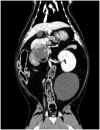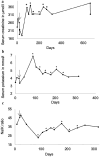Long-lasting hypoaldosteronism after adrenalectomy in a cat with hyperaldosteronism
- PMID: 38746623
- PMCID: PMC11092530
- DOI: 10.1177/20551169241243012
Long-lasting hypoaldosteronism after adrenalectomy in a cat with hyperaldosteronism
Abstract
Case summary: A 10-year-old neutered male domestic shorthair cat was presented with an abdominal mass, associated renal failure, chronic vomiting, anorexia and progressive polyuria/polydipsia lasting for 3 weeks. Clinical examination and initial blood work revealed azotaemia, hypokalaemia and hypertension. Abdominal ultrasound showed an adrenal mass with a diameter of 3 cm near the right kidney. High serum aldosterone suggested primary hyperaldosteronism. Surgery enabled identification of the mass and its excision along with the right adrenal gland. Histologically, carcinoma of the adrenal cortex was diagnosed. Postoperatively, an increase in serum creatinine and potassium, along with a low serum aldosterone, led to a diagnosis of hypoaldosteronism. Mineralocorticoid therapy for 6 months was necessary, resulting in clinical and biological improvement.
Relevance and novel information: To our knowledge, this case describes the longest-lasting reported secondary hypoaldosteronism in a cat, after unilateral adrenalectomy for an adrenal carcinoma with hyperaldosteronism.
Keywords: Hypokalaemia; endocrinology; surgical management; systemic hypertension.
© The Author(s) 2024.
Conflict of interest statement
The authors declared no potential conflicts of interest with respect to the research, authorship, and/or publication of this article.
Figures







Similar articles
-
Conn´s syndrome after kidney transplantation.Bratisl Lek Listy. 2024;125(4):258-263. doi: 10.4149/BLL_2024_39. Bratisl Lek Listy. 2024. PMID: 38526863
-
Gynaecomastia in a male neutered cat with an adrenal tumour and associated hyperprogesteronism, hypercortisolism and hyperaldosteronism.JFMS Open Rep. 2021 Sep 29;7(2):20551169211045640. doi: 10.1177/20551169211045640. eCollection 2021 Jul-Dec. JFMS Open Rep. 2021. PMID: 34616560 Free PMC article.
-
Infraspinatus muscle necrosis in a cat with primary hyperaldosteronism.JFMS Open Rep. 2024 Oct 17;10(2):20551169241282737. doi: 10.1177/20551169241282737. eCollection 2024 Jul-Dec. JFMS Open Rep. 2024. PMID: 39431239 Free PMC article.
-
Hyper- and hypoaldosteronism.Vitam Horm. 1999;57:177-216. doi: 10.1016/s0083-6729(08)60644-5. Vitam Horm. 1999. PMID: 10232050 Review.
-
Aldosterone-secreting adrenal cortical adenoma in an 11-year-old child and collective review of the literature.Eur J Pediatr. 1994 Oct;153(10):715-7. doi: 10.1007/BF01954485. Eur J Pediatr. 1994. PMID: 7813526 Review.
References
-
- Goncalves JA, Barrros R, Ferreira B, et al.. Severe hypoaldosteronism after unilateral adrenalectomy for primary hyperaldosteronism. Endocrine Abstracts 2017; 49. DOI: 10.1530/endoabs.49.EP30.
-
- Shrikrishna N, Koko N, Jones E, et al.. Case of prolonged hypoaldosteronism after unilateral adrenalectomy for Conn’s syndrome. Endocrine Abstracts 2016; 44. DOI: 10.1530/endoabs.44.EP9.
-
- Niessen SJM. Hyperaldosteronism in cats. Proceedings of the World Small Animal Veterinary Association World Congress, Cape Town, South Africa, 16 September 2014.
Publication types
LinkOut - more resources
Full Text Sources
Miscellaneous
